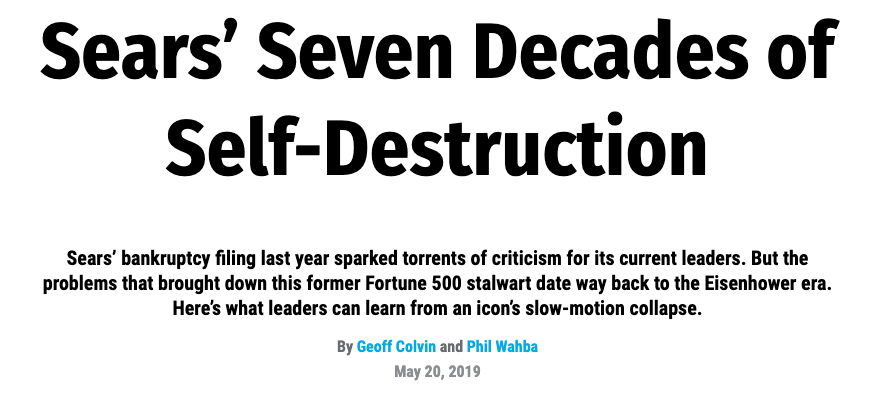
Pearland, TX City Manager Clay Pearson writes in part two of his guest blog about why local government benefits from regularly reading the business press. In this post, he explores this June 1, 2019 article in “Forbes” by Geoff Colvin with Phil Wahba.
The blog is an interpretation from the below article, substituting “Sears Corporation” with “City of Sears”.

I’ve worked in Elgin, Illinois. A once-thriving industrial, river city — A place that hosted an international industrial complex of synonymous watch production and milk distribution. Time and choices wore that position away.
Denying a new shopping center, forcing it to go across the municipal border to protect a downtown that hosted a retail center that later then itself bolted across the border to the new shopping center.
The jilted City of Elgin then tried pedestrian malls and saw retail areas convert to multiple tax-exempt social service agencies. The inner core residential area had single-family homes converted to multi-family rentals without the multi-family amenities or infrastructure for the density.
The school district had debilitating, well-publicized labor battles and strikes played out in the Chicago Tribune for the region residents to then categorize Elgin as “troubled.” White flight and economics were a strain on the supporting framework of the community.
These contextual challenges were immense. Even a riverboat casino and millions of dollars thoughtfully invested did not quickly correct the “store’s” trajectory.
Through it all, there were leaders, both elected and appointed, that ranged from professional to parochial to visionary. There was a city manager who hired me back in 1990 and let me learn and manage the budget and Capital Improvement Program (CIP).
He was visionary so much so that he got out front of the City Council and what it was able to digest. That capital improvement plan was ambitious and set the stage for what the City would become. He resigned the day that the casino license was granted to the city.
A successor city manager became a lifelong mentor for me, bringing focus on neighborhoods and protecting core service areas, implementing community policing, executing promises made, and holding staff accountable.
With good business practices for strategy and execution, the crown jewels of the downtown buildings, river island, and Victorian painted houses were renewed and began to shine again.
Now Elgin has risen to new heights. Public safety is enhanced. The City has a AAA-credit rating. The city now competes among the other competitive cities around Chicago. Elgin could have been Sears, but sound leadership, good decisions, and a sense of urgency avoided failure.
The business book, The Upside of the Downturn: Ten Management Strategies to Prevail in the Recession and Thrive in the Aftermath, also by Geoff Colvin provides another guide to cities can learn from businesses and purposefully and proactively manage through the deep challenges.
This was the case in another city where I worked, the City of Novi, a suburb of Detroit. Detroit itself is the quintessential American city with a surge-and-decline story. Suburbs benefitted from the troubles of Detroit. Specifically, Novi created a virtuous circle of value and investment in people, jobs, education, resources, and amenities. Novi created a quality of life now second to none.
Roads, housing, first-class library, parks, trails, restaurants and bars, are now in place. During the 2008 post-recession, however, there was a reckoning that intensified the virtuous circle.
This is where Colvin’s advice became helpful. The Mayor and Council supported the professional staff as we adjusted and restructured “the business.” There were no presumptive political constraints put in our way. Everything was considered from changing font type and size to save ink costs to restructuring firefighter schedules.
Staff reductions were made including lay-offs of long-tenured friends. Investments continued, however, in staff training and professional development, building capacity wherever possible. Rather than declining in the recession, I believe that Novi emerged stronger.
Business Sector Examples for Public Leaders
City management does not operate in isolation. It operates in a system that can learn from businesses. The business practices we learned in school need to be challenged and updated.
Business newspapers and magazines such as the Economist (the best), Fortune, Harvard Business Review, Bloomberg BusinessWeek, the Financial Times and the Wall Street Journal all provide insights that provide valuable perspectives for public administrators.
Following them on Twitter, going to the public library, or subscribing are professional development investments in yourself. Public administrators can learn from the innovations and trends impacting business and evaluate their applicability to the public sector.
Understanding your city’s marginal revenue, fixed costs, and the risks of not investing in physical “store” can keep the locality falling into the Sears spin cycle.
When we in professional local government get charged to `act like a business’, we should find the many bad examples to avoid and take the best to apply actively, energetically, and boldly.
